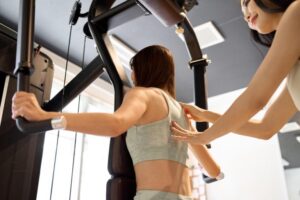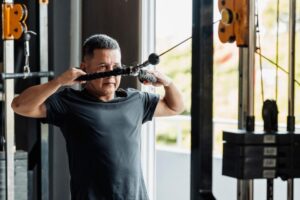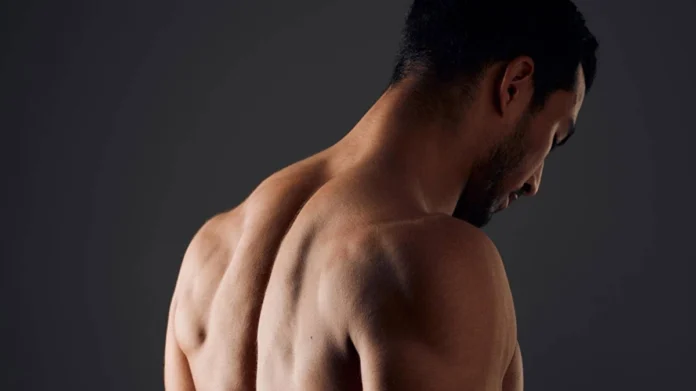Bent Over Lateral Raise: This exercise, performed by leaning forward slightly with dumbbells, isolates the posterior shoulder muscles and works them effectively. Very efficient results are achieved with the correct position and controlled movement.

- Reverse Fly: Performed using dumbbells, cables, or machines, this exercise effectively targets the muscles between the shoulder blades as well as the posterior shoulder muscles. It works particularly well with the back muscles.
- Face Pull (Rope Face Pull): Face pulls performed with a rope attachment at a cable station work the upper back muscles along with the rear shoulders.
- Rear Delt Row: It is performed similarly to the bent-over row movement, but the elbows are pulled to a wider angle. This directly activates the rear deltoid muscles.
- Cable Rear Delt Fly: Cable rear shoulder movements performed in a crossed position using a cable machine isolate the rear shoulder muscles and provide an effective workout with fixed resistance.
- Reverse Pec Deck Fly: Performed with arms held at shoulder height, this machine exercise makes it easier to maintain form and focuses on the posterior shoulder muscles.
- Single Arm Bent Over Raise: This variation, performed with dumbbells, improves balance and muscle control by focusing on one arm. It is an ideal option for symmetrical muscle development.
- Incline Rear Delt Raise: This exercise, performed in a prone position on an incline bench, stabilizes the body and allows the rear shoulder muscles to work more effectively.
- Standing Reverse Cable Cross: The cables held on both sides are pulled at cross angles to target the posterior shoulder muscles. This movement provides support in improving balance and muscle control.

Seated Bent Over Dumbbell Raise: A variation performed seated for those who have balance problems while standing. It effectively works the rear shoulder muscles without putting any pressure on the waist area.
The Most Effective Back Shoulder Exercises
The most effective rear shoulder exercises are determined by the level of muscle activation, and scientific research highlights movements that work the rear deltoid muscle at its maximum level. A few basic movements that experts and sports scientists agree on provide great advantages in terms of both isolation and stability. Effective rear shoulder exercises can be listed as follows:
- Face Pull: According to EMG (electromyography) analysis, it is one of the movements that provides the highest muscle activation in the posterior shoulder. It works both the posterior deltoid and trapezius muscles effectively.
- Reverse Pec Deck Fly: This movement, performed with machine support, facilitates the maintenance of form and provides constant resistance to the muscles. It is very effective in terms of posterior shoulder isolation.

- Bent Over Lateral Raise: This classic move, done with free weights, requires balance and control, making the muscles work more actively. The range of motion is wider thanks to the use of dumbbells.
- Cable Rear Delt Fly: The constant tension provided by the cable system helps keep the rear delt muscles active throughout the entire repetition. Both the shortening and lengthening phases of the muscle work in a controlled manner.
- Incline Rear Delt Raise: This movement, performed on an incline bench, allows the body to be fixed and only the rear shoulder muscles to work. It minimizes the risk of incorrect form.
Dumbbell Back Shoulder Exercises
Dumbbell rear shoulder exercises are an indispensable part of free weight training. These exercises, which are effective in isolating the posterior deltoid muscles, contribute to upper back and shoulder stability. The fact that they can be done at home or in the gym makes dumbbell rear shoulder exercises quite accessible.
Dumbbell Bent Over Reverse Fly is one of the basic movements that target the rear shoulder. Standing, with the knees slightly bent and the torso leaning forward, the dumbbells are lifted to the side. These dumbbell shoulder movements engage the rear deltoid as well as the trapezius and rhomboid muscles. It is important to keep the back straight, to perform the movement in a controlled manner, and not to swing the weight. It is usually applied in 3 sets of 10-12 repetitions.
Dumbbell 4 Ways Lateral Raise is an ideal movement to work different parts of the shoulder in the same session. The dumbbells are lifted forward, sideways, diagonally, and upwards, respectively, providing muscle activation in four different directions. In rear shoulder lateral applications, the rear shoulder, as well as the front deltoid and upper trapezius muscles, are also involved.
Fast movements should be avoided, and each repetition should be done in a controlled manner. 6 repetitions are recommended in each direction per set. Dumbbell Lying Rear Lateral Raise is an exercise performed by lying face down on an incline bench, making it easier to control the range of motion. The rear deltoid muscles work intensively while the dumbbells are lifted sideways. At the same time, auxiliary muscles such as the trapezius and infraspinatus are also active. It can be applied as 3 sets of 10-15 repetitions.
Back Shoulder Exercises with Rope
Rear shoulder movements are among the effective exercises performed using rope applications and cable stations, and provide continuous tension on the muscle. These types of exercises are ideal for those who want to isolate the rear deltoid muscles and work them in the right form. Since movements performed with ropes provide longer-term activation of the muscles, they offer advantages in terms of both muscle endurance and aesthetic development.
The Bent Over Cable Reverse Fly movement is performed by leaning the body forward. The ropes are held crosswise from the cable machine placed on both sides. The body is leaned forward so that it is parallel to the floor, and the arms are pulled to the side with a slight bend in the elbows. This movement directly targets the rear shoulder muscles while also working the trapezius and rhomboid muscle groups as support.

Standing Cable Reverse Fly is performed in an upright position. The ropes are held at shoulder level or slightly below. The arms are opened to the sides, keeping the elbows fixed. This movement effectively works the rear deltoid, while the middle trapezius and rear back muscles are also engaged. It should be performed slowly and in a controlled manner without compromising form. 3 sets of 10-15 repetitions are appropriate.
Back Shoulder Exercises at Home
For those who do not have the opportunity to go to the gym, rear shoulder exercises at home offer effective and practical solutions. Especially when equipment is limited, it is possible to work the rear shoulder muscles with materials that are easily found at home, such as a resistance band, towel, or water bottle. These exercises support the shoulders to look balanced and strong by isolating the rear deltoid muscles.
The Towel Rear Deltoid Fly is a simple but effective exercise that can be done at home. You can hold a towel in both hands, lean your body forward slightly, and open your arms to the sides. This exercise works the muscles in the upper back as well as the rear shoulder.
It is important that the shoulders are stable and controlled during the movement. 3 sets of 12-15 repetitions are ideal. The Band Pull Apart is done using a resistance band. You can hold the resistance band with both hands and slowly open the band to the side while keeping your arms straight in front. This exercise activates the rear shoulder muscles as well as the trapezius and rhomboids.
Best Back Shoulder Program
Rear shoulder development movements are critical for the shoulder to look balanced and aesthetic. You can effectively develop this muscle group with a properly planned training program. Your weekly program should be organized according to your level and movement selection, number of sets and repetitions, and rest periods should be adjusted accordingly. Weekly rear shoulder programs from beginner to advanced level can be exemplified as follows:
Beginner Level (2 Days a Week)
- Dumbbell Bent Over Reverse Fly: 3 sets x 12-15 reps (60 sec rest)
- Band Pull Apart: 3 sets x 12-15 reps (60 sec rest)
- Towel Rear Deltoid Fly: 3 sets x 12-15 reps (60 sec rest)
Intermediate Level (2-3 Days a Week)
- Face Pull (Cable): 3-4 sets x 10-12 reps (45-60 sec rest)
- Standing Cable Reverse Fly: 3-4 sets x 10-12 reps (45-60 sec rest)
- Dumbbell 4 Ways Lateral Raise: 3-4 sets x 10-12 reps (45-60 sec rest)
Advanced (3 Days a Week)
- Bent Over Cable Reverse Fly: 4 sets x 8-10 reps (30-45 sec rest)
- Dumbbell Lying Rear Lateral Raise: 4 sets x 8-10 reps (30-45 sec rest)
- Cable Rear Shoulder Press: 4 sets x 8-10 reps (30-45 sec rest)

Why is the Posterior Shoulder Important?
The posterior shoulder muscles are muscles located on the back of the shoulder area that are often overlooked but have great functional importance. From an aesthetic perspective, well-developed posterior shoulder muscles make the shoulders appear fuller, more symmetrical, and balanced. This strengthens the body posture and creates a more athletic silhouette. In terms of posture, having strong posterior shoulder muscles plays a critical role in preventing posture disorders such as a hunchback.
It is also very important for shoulder health that the posterior shoulder muscles are developed. These muscles increase the stability of the shoulder joint and reduce the risk of injury. Especially in weight training and daily movements, good functioning of the posterior shoulders protects the shoulder joint and increases mobility. In addition, the posterior shoulder muscles increase upper body performance by providing balance to the body.
How Many Repetitions Should You Do for Rear Shoulders?
Determining the correct number of repetitions for the development of the posterior deltoids makes a big difference in reaching your goals. In general, training goals are divided into three main groups: hypertrophy (increasing muscle mass), strength gain, and endurance, and the optimal repetition ranges for each goal are different. The ideal repetition range for those aiming for hypertrophy is usually recommended between 8-12 repetitions. This range allows for a balanced mechanical tension and metabolic stress that supports maximum growth in the muscle fibers.
For strength gains, lower repetitions are preferred. Usually, 4-6 repetitions are worked with high weights. This method strengthens the nerve-muscle connection and allows the muscles to produce more force, but it provides limited growth compared to muscle volume hypertrophy. Higher repetitions are recommended for endurance training. Shoulder expansion movements increase the resistance of the muscles to fatigue in male athletes and enable long-term performance development.
How Many Days a Week Should You Work the Rear Shoulder?
For optimal development of the posterior shoulder muscles, working twice a week is generally the most appropriate frequency. This frequency ensures that the muscles are sufficiently stimulated while also providing the time needed for recovery and growth. A posterior shoulder workout once a week may be sufficient, especially for beginners, but 2 days is recommended to accelerate muscle development. Advanced athletes can work the posterior shoulders 2-3 times a week by increasing the intensity and volume of training.
Working the posterior shoulder muscles twice a week is an ideal approach for effective development and healthy recovery. You can adjust this frequency according to your own level and training program. You can start doing sports with fitness posterior shoulder movements suitable for your body structure by consulting expert opinions.



